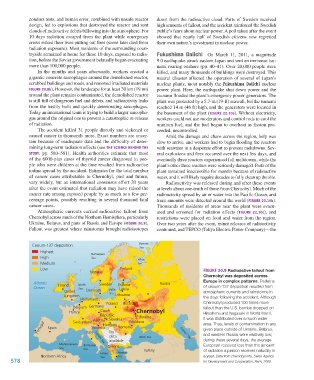Page 579 - Environment: The Science Behind the Stories
P. 579
conduct tests, and human error, combined with unsafe reactor down from the radioactive cloud. Parts of Sweden received
design, led to explosions that destroyed the reactor and sent high amounts of fallout, and the accident reinforced the Swedish
clouds of radioactive debris billowing into the atmosphere. For public’s fears about nuclear power. A poll taken after the event
10 days radiation escaped from the plant while emergency showed that nearly half of Swedish citizens now regretted
crews risked their lives putting out fires (some later died from their own nation’s investment in nuclear power.
radiation exposure). Most residents of the surrounding coun-
tryside remained at home for these 10 days, exposed to radia- Fukushima Daiichi On March 11, 2011, a magnitude
tion, before the Soviet government belatedly began evacuating 9.0 earthquake struck eastern Japan and sent an immense tsu-
more than 100,000 people. nami roaring onshore (pp. 40–41). Over 20,000 people were
In the months and years afterwards, workers erected a killed, and many thousands of buildings were destroyed. This
gigantic concrete sarcophagus around the demolished reactor, natural disaster affected the operation of several of Japan’s
scrubbed buildings and roads, and removed irradiated materials nuclear plants, most notably the Fukushima Daiichi nuclear
FIGURE 20.8b). However, the landscape for at least 30 km (19 mi) power plant. Here, the earthquake shut down power and the
around the plant remains contaminated, the demolished reactor tsunami flooded the plant’s emergency power generators. The
is still full of dangerous fuel and debris, and radioactivity leaks plant was protected by a 5.7-m (19-ft) seawall, but the tsunami
from the hastily built and quickly deteriorating sarcophagus. reached 14 m (46 ft) high, and the generators were located in
Today an international team is trying to build a larger sarcopha- the basement of the plant (FIGURE 22.10a). Without electricity,
gus around the original one to prevent a catastrophic re-release workers could not use moderators and control rods to cool the
of radiation. uranium fuel, and the fuel began to overheat as fission pro-
The accident killed 31 people directly and sickened or ceeded, uncontrolled.
caused cancer in thousands more. Exact numbers are uncer- Amid the damage and chaos across the region, help was
tain because of inadequate data and the difficulty of deter- slow to arrive, and workers had to begin flooding the reactors
mining long-term radiation effects (see THE SCIENCE BEHIND THE with seawater in a desperate effort to prevent meltdowns. Sev-
STORY, pp. 580–581). Health authorities estimate that most eral explosions and fires occurred over the next few days, and
of the 6000-plus cases of thyroid cancer diagnosed in peo- eventually three reactors experienced full meltdowns, while the
ple who were children at the time resulted from radioactive plant’s other three reactors were seriously damaged. Parts of the
iodine spread by the accident. Estimates for the total number plant remained inaccessible for months because of radioactive
of cancer cases attributable to Chernobyl, past and future, water, and it will likely require decades to fully clean up the site.
vary widely, but an international consensus effort 20 years Radioactivity was released during and after these events
after the event estimated that radiation may have raised the at levels about one-tenth of those from Chernobyl. Much of the
cancer rate among exposed people by as much as a few per- radioactivity spread by air or water into the Pacific Ocean, and
centage points, possibly resulting in several thousand fatal trace amounts were detected around the world (FIGURE 20.10b).
cancer cases. Thousands of residents of areas near the plant were evacu-
Atmospheric currents carried radioactive fallout from ated and screened for radiation effects (FIGURE 22.10c), and
Chernobyl across much of the Northern Hemisphere, particularly restrictions were placed on food and water from the region.
Ukraine, Belarus, and parts of Russia and Europe (FIGURE 20.9). Over two years after the event, minor releases of radioactivity
Fallout was greatest where rainstorms brought radioisotopes continued, and TEPCO (Tokyo Electric Power Company)—the
Cesium-137 deposition Barents
Sea
Highest
Norwegian
High Sea
White
Medium Sea
Low Finland FIGURE 20.9 Radioactive fallout from
Norway
Chernobyl was deposited across
Atlantic Ireland North Sweden Estonia Russia Europe in complex patterns. Patterns
Ocean Sea Baltic Latvia of cesium-137 deposition resulted from
United Denmark Sea atmospheric currents and rainstorms in
Kingdom Lithuania the days following the accident. Although
Netherlands
Poland Belarus Chernobyl produced 100 times more
Belgium Germany fallout than the U.S. bombs dropped on
France Czech Chernobyl Hiroshima and Nagasaki in World War II,
Republic Ukraine
Austria Slovakia Moldova it was distributed over a much wider
Switzerland
Portugal Spain Slovenia Hungary Romania given place outside of Ukraine, Belarus,
area. Thus, levels of contamination in any
No
Italy
data Black Sea Caspian Sea and western Russia were relatively low;
available during these several days, the average
Adriatic Sea
Mediterranean Tyrrhenian European received less than the amount
Sea Sea Greece Turkey of radiation a person receives naturally in
Ionian Aegean
Northern Africa Sea Sea a year. Data from chernobyl.info, Swiss Agency
578 for Development and Cooperation, Bern, 2005.
M20_WITH7428_05_SE_C20.indd 578 13/12/14 1:56 PM

